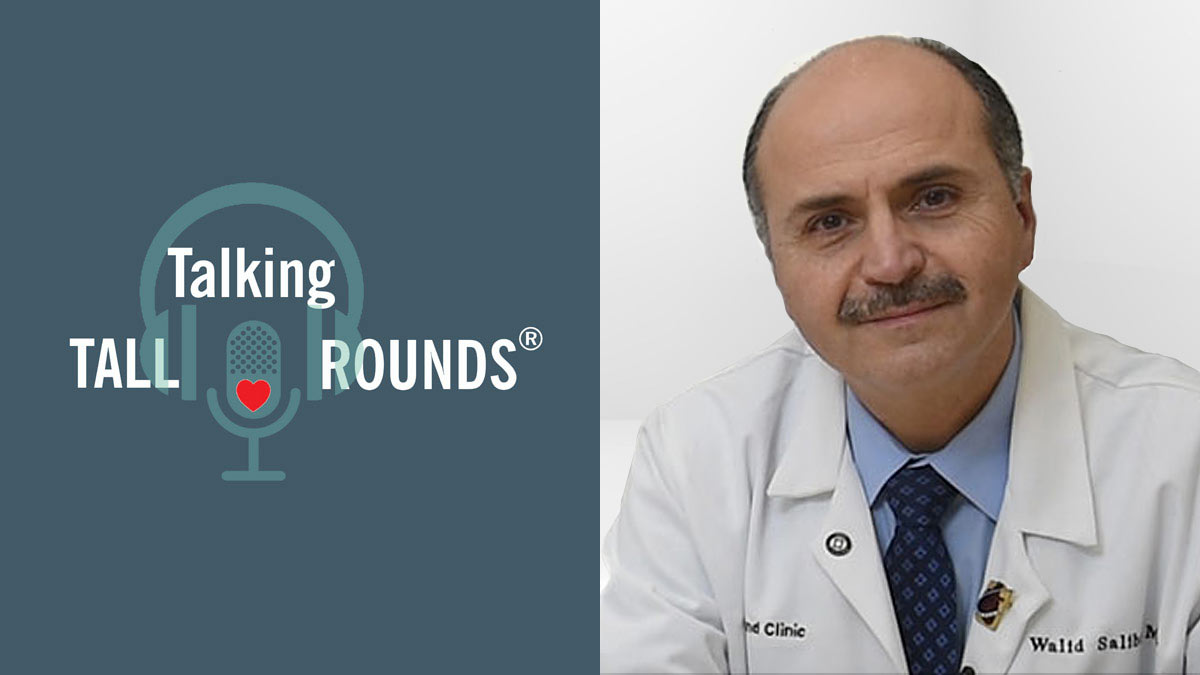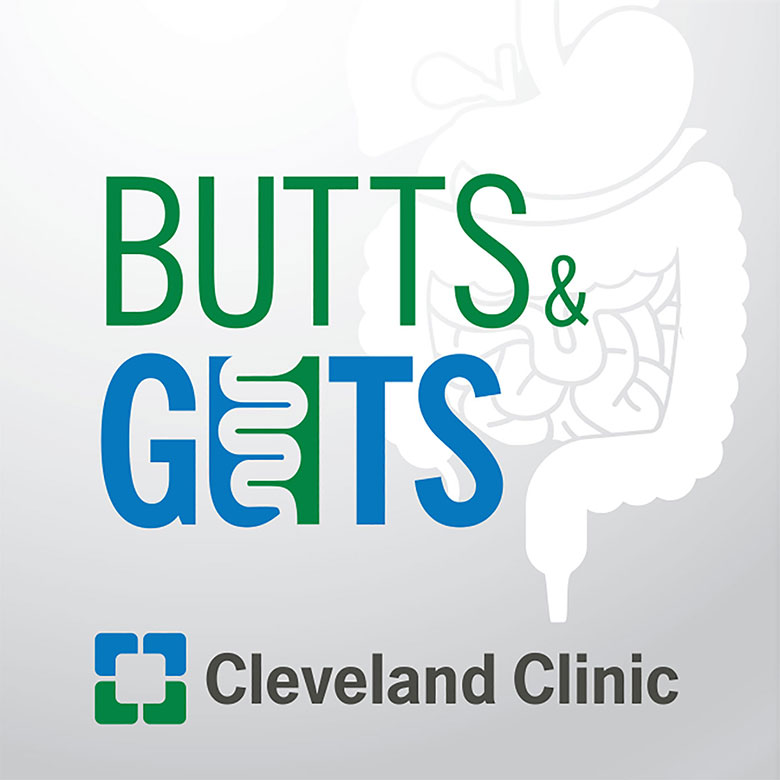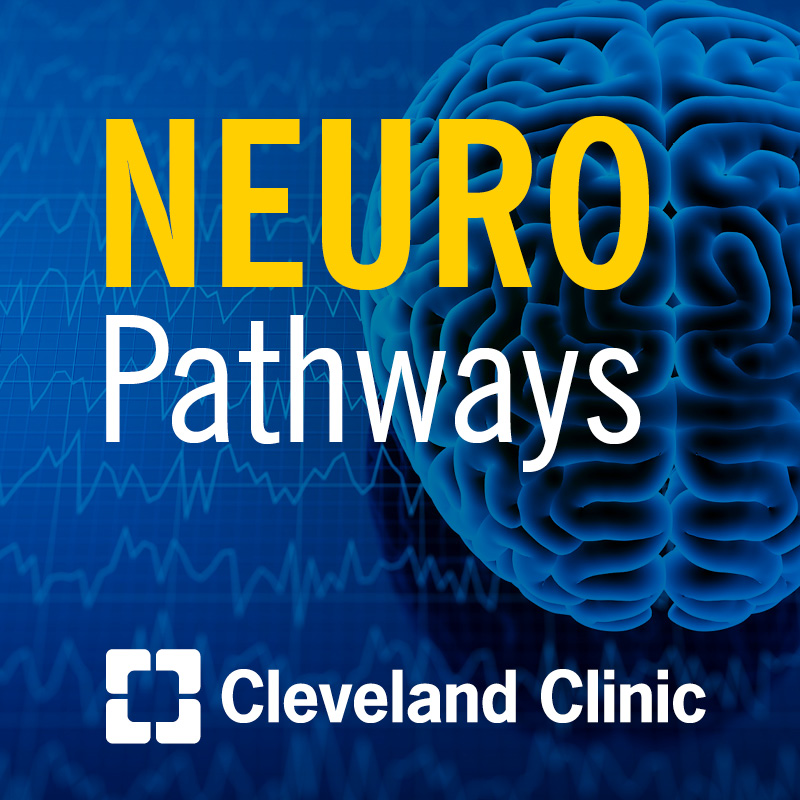Talking Tall Rounds®: Approaches to Left Atrial Appendage & Occlusion

Dr. Walid Saliba provides an update on the treatment of left atrial appendage.
Enjoy the full Tall Rounds® and earn free CME
- Case Presentation: Kevin Trulock, MD
- LAA Imaging and Clot Management: Serge Harb, MD
- Surgical Management of LAA: A. Marc Gillinov, MD
- LAA Occlusion- Cleveland Clinic Experience: Ayman Hussein, MD
- Concomitant Procedures - TAVR + LAAC: Amar Krishnaswamy, MD
- Concomitant Procedures - Ablation + LAAC: Walid Saliba, MD
Subscribe: Apple Podcasts | Podcast Addict | Buzzsprout | Spotify
Talking Tall Rounds®: Approaches to Left Atrial Appendage & Occlusion
Podcast Transcript
Announcer:
Welcome to the Talking Tall Rounds series, brought to you by the Sydell and Arnold Miller Family Heart, Vascular and Thoracic Institute at Cleveland Clinic.
Walid Saliba, MD:
Good morning. Thank you for joining us for Tall Rounds. Today, we had a wonderful discussion and an update about left atrial appendage occlusion, percutaneous and surgical, our experience at the Cleveland Clinic, as well as the surgical experience. We started by presenting a case of persistent left atrial appendage clot following an ablation procedure and how this was managed with anticoagulation and eventually successful left atrial appendage occlusion device placement.
We moved on to investigate the different imaging modalities for the left atrial appendage, be it with TEE, CT scan, and MRI, and Dr. Harb explained some of the treatment options that we have whenever we encounter the clot in the left atrial appendage. And then we talked about the surgical management of left atrial appendage. Dr. Gillinov explained that if you have atrial fibrillation, it is advantageous to actually clip the left atrial appendage using the left atrial appendage clipping, which is one of the better tools with a higher success rate than the usual suturing and ligation. If you do not have atrial fibrillation at the time of the surgery, then it might not be too much benefit to clip the left atrial appendage, although this is controversial, and we're looking for more research to come about that.
Dr. Ayman Hussein presented our experience with left atrial appendage closure percutaneously with the Watchman device, which is the only device approved in the United States. We involved very high-risk patients with high CHADS-VASc score, as well as patients who are at the high risk of bleeding, with excellent results in terms of reducing the risk of bleeding, being able to go off anticoagulation, and reducing the risk of stroke with percutaneous Watchman device placement.
Finally, we talked about the concomitant procedure, the TAVR-WATCH study, which involves patients with aortic valve stenosis, who do have... 30 to 40% of these patients have concomitant atrial fibrillation. These patients might benefit from oral anticoagulation, and we're trying to see if those patients would benefit from a left atrial appendage occlusion device with the Watchman. So this is a study that is randomized to standard medical therapy with oral anticoagulation following TAVR, versus a Watchman device placed at the time of the TAVR procedure.
And finally, we talked about the OPTION study from the EP standpoint, and these are patients who are not at high risk of bleeding. These are patients presenting with atrial fibrillation for an AFib ablation. We're going to randomize them to either a medical control group, which is oral anticoagulation with NOAC, versus placing a Watchman device at the time of the procedure or three to six months following the AFib ablation and see what is their bleeding risk, what is their stroke risk, and is this an okay kind of approach to address the risk of stroke in patients with atrial fibrillation presenting for an AFib ablation?
Thank you very much for listening today, and we invite you for attending future Tall Rounds. I'm sure that we will have lots of new discussions as well as subjects that are of interest to you. We'll be happy actually to start up discussions even over the net. Unfortunately, today we did not have that, but whenever we have time, it's always good to have those discussions and have a different picture or a sight of what is done in our affiliate hospitals and even outside the United States. Thank you very much.
A. Marc Gillinov, MD:
It looks like on the schedule today, about 15 people are going to have heart surgery. In every single one of them, the left atrial appendage is going to be visible, accessible. It's right there. And the question I'm going to answer is, what should we do in these 15 people today? Should we ignore it, exclude it, cut it off, oversew it? Here come the answers.
Here's a typical case. A 72-year-old woman has severe degenerative mitral valve disease from prolapse, longstanding persistent atrial fibrillation. She's got an indication for surgery because she's symptomatic. The mitral valve is pretty easy. Fix it. But the treatment of the left atrial appendage and the atrial fibrillation is a little more controversial. Here's the intra-operative TEE showing P2 flail, severe MR. This patient had a sternotomy, valve repair by atrial maze, and the left atrial appendage was oversewn from inside the left atrium, which all looked good and sounded good.
Standard IHR lesion set, very effective at treating her AFib. Post-repair echo shows that we know the mitral valve works, so that part of the operation was effective and successful. She had some peri-op AFib. We see that all the time, but she was discharged in normal sinus rhythm on amiodarone and warfarin. We send all these people home on temporary anticoagulation, at least meant to be temporary. And her pre-discharge echo showed no MR, and as far as we could see on transthoracic echocardiography, no flow in the left atrial appendage.
At three months, she had a Holter, no AFib. Her warfarin was stopped. Her amniodarone had already been stopped. So everything looked good. We were done with her until she presented to an outside hospital with a TIA and recurrent AFib. This generated a late night call. She was transferred to the Cleveland Clinic. She underwent studies over the next couple of days, and here's her left atrial appendage. Not only is it open, but she's got a thrombus. So a bad result of surgical treatment of the left atrial appendage. Her thrombus resolved on warfarin. She was switched to a NOAC, and she's got lifelong anticoagulation.
Could we have done better with her appendage? Yes. Her main fear now going forward for the rest of her life is the fear of stroke. A lot of people ask, "Is it the left atrial appendage or the heart rhythm?" And in this patient, the left atrial appendage is the target. The left atrial appendage is the problem. We've known that for a long time in surgery. This is an article that's almost 20 years old asking the question I started with. Surgeons see the left atrial appendage every single day in the operating room. What should we do?
The indications today are relatively clear. Should we manage the left atrial appendage in the operating room? If the patient's got isolated atrial fibrillation or concomitant atrial fibrillation, for sure. Mitral surgery and no AF? The guidelines say maybe. I say no. Other cardiac surgery, all these other people in the operating room today who have never had AFib, should we treat the appendage? I would suggest no, and I'll show you the data.
This is a paper that came out in JAMA this year. And this paper looked at people who had atrial fibrillation, and the appendage was treated. And they've got a bunch of curves, readmission for thromboembolism, mortality, stroke, and a composite endpoint. And the people who had the appendage treated, these are all people with Afib, those who had the appendage treated are the yellow curves, a lower event rate overall. So in people with AFib in this retrospective, observational, but large study, treating the appendage appeared to confer a benefit.
A subsequent study in JAMA, which got confused and sort of conflated with the first one, looked at patients who both had AFib and some who did not. And if you look at stroke overall, people who had the appendage treated now are on the blue line, they appeared to do better. In the middle, patients with AFib at baseline, appendage treated, fewer strokes. But if you look to the far right, patients without AFib at baseline, treated the appendage, appeared to have no impact. And the same was true for mortality. This study actually supports the previous study, supporting the idea that if you've got AFib and the appendage is treated, you do better. But if you don't have AFib and the appendage is treated, it appears to be neutral.
That said, if we're going to treat the appendage in the operating room, we've got to do a better job than we did with that case I presented. Surgical options have to work. We try not to do bad surgery. The ideal procedure in the operating room is going to be complete and permanent. It's going to be easy, and it's going to have no risk of bleeding. Until now, or recently at least, that's been unavailable.
This is a study from the Cleveland Clinic that was published in JACC by Anne Kanderian, who was one of the fellows in cardiovascular medicine. And she looked at TEEs obtained opportunistically in people who had had the appendage treated by some very good surgeons, guys you might remember, Cosgrove, Lytle, others. And what she found was treatment of the appendage in these expert hands was not very successful. Excision successful 73%, meaning they left a stump. Exclusion with a suture purse-string rarely worked, and stapling didn't work at all.
Stapling seemed to be a good idea. This is an artist's interpretation of the stapler, where we've stapled off the appendage. It looks good from the outside, but on the inside it more often than not looked like this: partial appendagectomy. If I have appendicitis, take out the whole thing. Don't leave me part of it. Same thing with the appendage.
Others thought, "Well, maybe those Cleveland Clinic surgeons just don't know what they're doing." We, of course, were upset by this conjecture. So Pat McCarthy, after he left here, did a study, a randomized controlled small study, in which they treated the appendage either by cutting it off, oversewing it, or other techniques. And they failed 57% of the time. So this is actually good surgeons focused on the appendage can't get it right with standard surgical technique. How did it fail? Bleeding, recurrent blood flow, residual stump.
There are consequences to doing a bad job in the operating room with anything, and the appendage is no different. In this study, they looked at 50 patients who had endocardial suture ligation of the appendage, meaning it was just oversewn. In about a third, there was residual flow. And those people with residual flow have thrombus or spontaneous echo contrast half the time. And many of them suffered thromboembolic events, presumably from the appendage.
So that led Toby Cosgrove and others to come up with a device to treat the appendage, which is really simple. It's a clip. It wasn't so simple to make. It took engineers years to come up with something that works. And when you look inside after this has been placed, you see just a tiny line where the appendange used to be. So this thing actually works. If you look at a 3D CT before applying the clip and then three years later, the appendage is involuted, gone. It's not just electrically isolated. It is absolutely gone.
Most importantly for surgeons at the time of the operation, this never bleeds, and it never opens. So in answer to this question from Dr. Cox, who invented the maze procedure, "Is it time to be more aggressive in the operating room with the appendage?" I think the answer is yes if the patient has atrial fibrillation. But until and unless we have more data, the answer is no if the patient does not have atrial fibrillation. And certainly for surgeons, this is a target, a surgical target in the patient with AFib, but in the patients without AFib, it's a target for further investigation. Thank you.
Ayman Hussein, MD:
So I'll share with you the Cleveland Clinic experience with percutaneous left atrial appendage occlusion. As Dr. Harb and Dr. Gillinov mentioned, stroke prevention is a critical aspect of the management of atrial fibrillation, and the appendage is often a target. And over the past decade, there have been actually multiple devices that were introduced for the purpose of closing the appendage percutaneously. Some of them are still investigational, but the one that we accumulated most experience with is the Watchman device, which was approved by the FDA back in 2015.
This is our first report actually describing our first experience back in 2018 that was reported last year, presented at the Heart Rhythm Society Meeting, between 2015 and 2017. And this includes only the post-FDA-approval Watchman patients. We had about 200 patients. The typical anticoagulation strategy in these patients have been 45 days of warfarin with an INR target of two to three, followed by four and a half months of dual antiplatelet therapy, especially if, well, only when the TEE at 45 days shows no device leak that is five millimeter or greater. Eventually, after that time period, this is followed by lifelong aspirin.
But I mention here the NOACs because we were among the first centers to start actually to do that with NOAC therapy, and I'll share some data about that with you. So, as I explained, anticoagulation is needed at the time of appendage occlusion, primarily to allow epithelialization of the Watchman device. So these procedures are done with uninterrupted anticoagulation. Patients get the cardiac CT to define the appendage anatomy. And intra-procedurally, everybody gets an intracardiac echo and TEE guidance, intracardiac echo to assist with the transseptal puncture and to also monitor for complications during the procedure.
With TEE, what we typically do is that we get measurements of the appendage and eventually confirm position of the device and appropriate compression to ensure stability and prevent dislodgement. Patients typically stay in the hospital overnight and come back at 45 days for their follow-up.
As I mentioned, we were among the first centers to report on doing Watchman implants with NOACs. Initially, the clinical trials which led to the approval of the device were done with Coumadin. And in this initial report, which we published back in 2017, we showed that NOACs are actually safe to be used in appendage occlusion with Watchman and found to be safe without increasing bleeding or thrombotic complications.
We were also among the first centers to report our experience with high-risk patients. The clinical trials which led to the approval of the Watchman device eventually included patients who were eligible for Coumadin therapy, so, as such and by definition, excluded patients who had some major or serious bleeding events. This was a small report of about 20 patients reporting our experience back in 2016, showing that with a careful multidisciplinary evaluation, and that is involving gastroenterologists, a neurologist, neurosurgeon, making sure that patients who experienced previous bleeding events could undergo Watchman. And most of the time, these patients were referred for Watchman implant and underwent a successful Watchman implant, eventually tolerating short-term anticoagulation, which was needed as I explained, and all of them were able to come off anticoagulation.
And this actually became our standard or actually our standard technique or our standard strategy. Most of our patients are eventually high-risk patients at the Cleveland Clinic, with 75% of this initial series having had a prior major bleeding event. And as I explained, a lot of patients were undergoing placement with NOAC, and I'm sure the numbers actually have changed in favor of NOAC more recently. Importantly, if you look at the characteristics of our population, we have a CHADS-VASc score of about 4.6, with a HAS-BLED score of about four, underscoring the importance of the Watchman in this population. This is a high-risk population at risk of both bleeding on anticoagulation and stroke off anticoagulation.
In this initial series, peri-procedural complications included only four groin hematomas, about 2%, but the device was implanted in 95% of patients successfully. At 45 days, TEEs showed a peri-device leak that is greater than five millimeter in none of the patients, which is important. Device-related thrombi was not observed in any of the patients. And everybody except two, which is 98%, were able to complete their 45 days required course of anticoagulation. About three patients needed to stop anticoagulation because of bleeding complications within the first 45 days.
Upon follow-up into a year, about 15% of patients had some bleeding complications, but not all of them were on anticoagulation. Some of them were on dual antiplatelet therapy. And with the use of NOAC and increasing use of NOAC, we transitioned actually in our practice from, let's say, NOAC and then dual anti-platelet to doing a longer course of NOAC and eventually stopping at three or four months after implant, as long as the TEE at 45 days shows no significant leak. And in this population, which I show to you as high risk of stroke, only 2% had an ischemic stroke event up to a year of follow-up. And I'll put that in context in the following slides.
So, as I explained to you, 95% was our success rate in terms of implant. And the limitations here relate primarily to the anatomy of the appendage. It's either too large, too small, or the actual multilobar anatomy, as Dr. Harb showed. So this is our characteristics of the population, showing that we are implanting here at CCF primarily high-risk patients compared to published studies and registries. Yet, we were able to achieve this with very low complication rates here. Procedural or device-related adverse events in about 2%, contrasting with the literature anywhere from 4 to 9%. Pericardial effusions in that initial series, none. And procedure-related stroke in that initial series, none.
And then we expanded further on our reports. And we just reported a few months ago our experience with appendage closure in patients or occlusion in patients who had prior intracranial hemorrhage. This is technically considered a high-risk group of patients with concerns primarily about re-bleeding events. Of course, working closely with our neurology team, our neurosurgeon, we included here about 38 patients who had both AFib and prior intracranial hemorrhage, and we brought them for a Watchman implant. The time actually from event to implantation was about 630 days, but a minimum of 60 days after their bleeding events. In all of these patients, actually, the Watchman was implanted without peri-procedural complications. And we showed that, over follow-up, none of these patients experienced recurrence of their intracranial bleeding events and were eventually able to come off anti-coagulation.
Expanding further on our experience, especially that we are including primarily high-risk patients, in this paper we just published last month, we report on our left atrial appendage closure in patients who are at very high risk of stroke. So in this group, actually, we included patients who had the CHADS-VASc of five or more, and this is typically a very high-risk group of patients. And actually in this group, we were able to implant Watchmans and eventually stop anticoagulation in all of them. Here showing that over the follow-up, only 2.8% in this group had a stroke over follow-up. But if we compare that to a typical age and gender and CHADS-VASc matched patient, the estimated annual risk of stroke in such patient would be 12% without anticoagulation and greater than 4% on warfarin. But it was again 2.8% with Watchman implant, allowing stopping anticoagulation.
And I'll share with you here some more recent numbers. This is reporting 2015 to 2018. We've implanted so far about 335 Watchman devices. About 18 could not be implanted due to anatomy of the appendage, which makes our success rate about 95%. And major procedure-related complications in the hospital happened in two patients only. One patient had an effusion, and one patient had an esophageal bleed likely related to injury from TEE at the time of the procedure. In this series of patients, about 350 patients, about 90% of them were off anticoagulation at six months. Thank you so much.
Announcer:
Thank you for listening. We hope you enjoyed the podcast. Like what you heard? Visit Tall Rounds online at clevelandclinic.org/TallRounds and subscribe for free access to more education on the go.

Cardiac Consult
A Cleveland Clinic podcast exploring heart, vascular and thoracic topics of interest to healthcare providers: medical and surgical treatments, diagnostic testing, medical conditions, and research, technology and practice issues.



